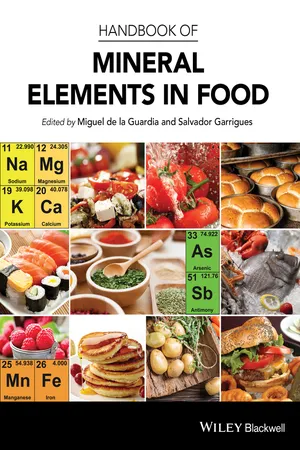
- English
- ePUB (mobile friendly)
- Available on iOS & Android
Handbook of Mineral Elements in Food
About this book
Mineral elements are found in foods and drink of all different types, from drinking water through to mothers' milk. The search for mineral elements has shown that many trace and ultratrace-level elements presented in food are required for a healthy life. By identifying and analysing these elements, it is possible to evaluate them for their specific health-giving properties, and conversely, to isolate their less desirable properties with a view to reducing or removing them altogether from some foods. The analysis of mineral elements requires a number of different techniques – some methods may be suitable for one food type yet completely unsuited to another.
The Handbook of Mineral Elements in Food is the first book to bring together the analytical techniques, the regulatory and legislative framework, and the widest possible range of food types into one comprehensive handbook for food scientists and technologists. Much of the book is based on the authors' own data, most of which is previously unpublished, making the Handbook of Mineral Elements in Food a vital and up-to-the-minute reference for food scientists in industry and academia alike. Analytical chemists, nutritionists and food policy makers will also find it an invaluable resource.
Showcasing contributions from international researchers, and constituting a major resource for our future understanding of the topic, the Handbook of Mineral Elements in Food is an essential reference and should be found wherever food science and technology are researched and taught.
Frequently asked questions
- Essential is ideal for learners and professionals who enjoy exploring a wide range of subjects. Access the Essential Library with 800,000+ trusted titles and best-sellers across business, personal growth, and the humanities. Includes unlimited reading time and Standard Read Aloud voice.
- Complete: Perfect for advanced learners and researchers needing full, unrestricted access. Unlock 1.4M+ books across hundreds of subjects, including academic and specialized titles. The Complete Plan also includes advanced features like Premium Read Aloud and Research Assistant.
Please note we cannot support devices running on iOS 13 and Android 7 or earlier. Learn more about using the app.
Information
CHAPTER 1
The importance of minerals in the human diet
Keywords: mineral supplements; bioavailability; nutritional recommendations; human diet; food culture; micronutrients
1.1 Historical aspects
Table of contents
- Cover
- Title page
- Table of Contents
- List of contributors
- Preface
- CHAPTER 1: The importance of minerals in the human diet
- CHAPTER 2: Dietary intake of minerals
- CHAPTER 3: Bioavailability of minerals in foods
- CHAPTER 4: Human risk assessment and regulatory framework for minerals in food
- CHAPTER 5: The oligoelements
- CHAPTER 6: The toxic elements
- CHAPTER 7: Geographical variation of land mineral composition
- CHAPTER 8: Variation of food mineral content during industrial and culinary processing
- CHAPTER 9: Speciation analysis of food
- CHAPTER 10: Atomic absorption spectrometry
- CHAPTER 11: Elemental composition analysis of food by FAES & ICP-OES
- CHAPTER 12: New developments in food analysis by ICP-MS
- CHAPTER 13: Electroanalytical methods
- CHAPTER 14: X-ray
- CHAPTER 15: Vibrational spectroscopy
- CHAPTER 16: Ion chromatography
- CHAPTER 17: Neutron activation analysis of solid foods
- CHAPTER 18: Methodological aspects of speciation analysis in food products
- CHAPTER 19: Drinking water
- CHAPTER 20: Elemental composition in grapes and wine: role, analytical methods and their use
- CHAPTER 21: Vegetables and fruits
- CHAPTER 22: Cereals and pulses
- CHAPTER 23: Bread and bakery products
- CHAPTER 24: Edible fats and oils
- CHAPTER 25: Elemental composition of sugar and honey
- CHAPTER 26: Meat
- CHAPTER 27: Fish and seafood
- CHAPTER 28: Milk and dairy products
- CHAPTER 29: Mineral content of eggs
- CHAPTER 30: Mineral content of seasonings, salt and vinegar
- CHAPTER 31: Other foods of plant origin
- CHAPTER 32: Baby foods
- CHAPTER 33: Human milk
- Index
- Food Science and Technology Books
- End User License Agreement